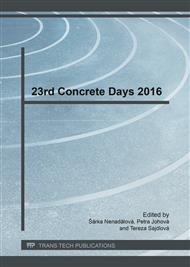[1]
M. Collepardi, The New Concrete, Grafiche Tintoretto, Milano, (2010).
Google Scholar
[2]
P. Pytlík, Technologie betonu, VUT – Brno, Brno, (2000).
Google Scholar
[3]
P. Pokorný, et al., The assessment of the impact of corrosion of galvanised steel on bond strength of plain bars with NSC, concrete, Koroze a ochrana materiálu, 59 (2015), 53-65.
DOI: 10.2478/v10227-011-0020-9
Google Scholar
[4]
R. Nováková, et al., Relation of corrosion simulators transport and modern concrete pore microstructure, Conference METAL 2015, Tanger (June 3rd – 5th 2015), p.6.
Google Scholar
[5]
S. Diamond, Mercury porosimetry: An inappropriate method for the measurement of pore size distributions in cement-based materials, Cement and Concrete Research, 30 (2000), 1517-1525.
DOI: 10.1016/s0008-8846(01)00619-6
Google Scholar
[6]
R. Nováková, et al., Influence of modern concrete microstructure on the diffusion of corrosion agents, Conference METAL 2016, Tanger (June 25th – 27th 2016), p.6.
Google Scholar
[7]
G. Song, Equivalent circuit model for AC electrochemical impedance spectroscopy of concrete, Cement and Concrete Research, 30 (2000), 1723-1730.
DOI: 10.1016/s0008-8846(00)00400-2
Google Scholar
[8]
J.W. McCarter, The application of impedance spectroscopy to cementitious systems, S. Limited, Edinburg, (1999).
Google Scholar
[9]
H. Hamilton, Permeability of concrete – camoparison of conductivity and diffusion methods, C-Press, Florida, (2007).
Google Scholar
[10]
D. Whiting, Rapid measurement of the chloride permeability of concrete, Public Roads, 45 (1981), 101-112.
Google Scholar


